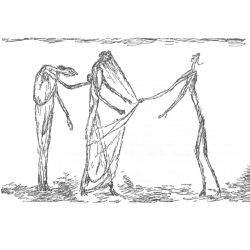 This is the first of two responses to an excellent article by Antony Slumbers, in this instance offering that his views offer too conservative a view of how technology will shape the future of work. Dr Pangloss, the teacher of metaphysics in Candide, Voltaire’s hilariously sarcastic attack on Leibnizian optimism, offered a timeless and universal explanation of the most cruel and tragic events as “the best of all possible worlds”. I would argue however that far from creating a landscape of optimism, it facilitates a dismissal of all significant change as an irrelevance given that effectively we have no option other than to happily accept it. For example, whether property transitions to a service or remains locked in its existing institutional quagmire, it doesn’t matter. Either way its fine as it’s the best we can hope for. Accept it, happily. A Panglossian future only looks appealing if you’re –well, Dr Pangloss.
This is the first of two responses to an excellent article by Antony Slumbers, in this instance offering that his views offer too conservative a view of how technology will shape the future of work. Dr Pangloss, the teacher of metaphysics in Candide, Voltaire’s hilariously sarcastic attack on Leibnizian optimism, offered a timeless and universal explanation of the most cruel and tragic events as “the best of all possible worlds”. I would argue however that far from creating a landscape of optimism, it facilitates a dismissal of all significant change as an irrelevance given that effectively we have no option other than to happily accept it. For example, whether property transitions to a service or remains locked in its existing institutional quagmire, it doesn’t matter. Either way its fine as it’s the best we can hope for. Accept it, happily. A Panglossian future only looks appealing if you’re –well, Dr Pangloss.
Give me back my broken night
my mirrored room, my secret life
… Leonard Cohen
Future gazing is always inherently limited by our understanding of the present. We are rarely able to shake off the weltanschauung that gifts us a frame of reference for all we know and all we are able to imagine. We are thinking and talking in a mirrored room, it offers us certainty, comfort and calm. This is particularly so where technology is concerned, especially where breakthrough moments occur, reaching beyond the incremental development of an idea. This in itself holds the key to a greater, genuine optimism. It is the leap beyond our world view, beyond the models and frames through which we understand and speculate, that intrigue. Property as a service is still property, conceived as an offering that bears a relationship to its present. If property were removed from the equation, that would be interesting. Optimism should always be veined with trepidation and excitement.
If we consider the wider workplace changes of recent years, they have been essentially driven by the pull of people – the ubiquity of social media and messaging platforms, BYOD, blogging, unconferences and self-organised events, and the use of apps and free software. In each case, the corporate response has lagged and policy and attempts at regulation have followed. For the body corporate it has been a little like Ledru-Rollin’s famous (yet probably apocryphal) cry during the 1848 French revolution of “I am their leader, I must follow them!” Such a spirit has fired the start-up industry over the last decade and made this possible. It has been characterised by a distinctly un-Panglossian outlook.
It is with this in mind that I have addressed the matters raised by Antony, considering that they are increments, small steps, revisions of existing metaphors. The provocation that follows holds that he has been unusually conservative in his outlook.
You should assume the office really is dead
The existence and nature of the office, essentially an unchanged physicality for over a hundred years, attracts considerable attention. Very often this emanates from the journalistic community, shoehorned into open offices while craving a yesteryear best encapsulated in the recent reflections from the writers of the Economist on the home they are due to leave after fifty two years. Yet the office is part of the superstructure, a consequence of the underlying infrastructure, in workplace terms the system of management, and the organisational culture it supports and is supported by. With the rolling automation of work tasks, a process that has been ongoing for millennia, the need for the physical focal point manifested as the office will change, but any challenge to its existence serves no purpose to the infrastructure.
I have argued before that one of the key trends in workplace design will be the convergence of design and functional influences from a number of areas – leisure, domestic, retail and hotel amongst others – and that we will soon merely reflect on “space”. Purpose and use will be entirely general, rather than specific. The existence of the office is assured, but as part of the genre of physical space. As to the future of work therefore we shouldn’t be concerned, as it has no causal bearing on anything significant at all.
Machine learning is a double edged sword
I built an expert system when I completed my MSc in IT in 1991. From a fairly simple decision tree, considering a range of inputs it created a marketing plan for a seven-inch single (remember those?). While the system didn’t learn per se, it still supported a rudimentary yet informed decision process using a 4GL shell. It was only a small step even then for such a system to learn, to modify its outputs based on the processing of inputs, to start on the long journey towards the replication of human neural networks and thought processes.
Yet computers learning is still directed, and much of the consideration of the automation of workplace roles is based upon instruction and response – even if the instruction is issued once, and the process continues and evolves for some time without interaction. The stage we are at is “where machine learning applies statistical models to the data you have in order to make smart predictions about data you don’t have” (HBR, Nov 2015). When machines decide what they wish to learn and how, our relationship will have changed. This self-direction and self-determination takes us beyond our existing understanding of machine learning. Machines will eventually be able to freely decide which roles they automate. The double-edged sword will be in the hands of the Centimanes.
The death of distance will re-appear
The error here is to think of distance merely in the physical domain. We also use the metaphor of physical instance to explain alienation, misunderstanding, misalignment. We can be or be perceived to be distant in the company of others, when our attention of focus is elsewhere, when we don’t wish to be where we are. The relationship with technology here is interesting, when we remove the physical presence and the sensory components that make interaction uniquely human. We may be able to bridge geographical divides through replication of the human form – telepresence, virtual reality for example – but the distance we will feel will be exacerbated by the removal of the complete sensory experience. Our communication will lack dimensionality, distance will be represented and understood in terms of what is missing. Speaking over screens has been with us for a long time. The next frontier for technology, and the death of distance in the fullest sense, is the replication of the entire sensory experience in human communication. Only then will distance be conquered.
There is no such thing as work/life balance, and that is good
It was commonplace for a highly-regarded commentator in recent years to talk of the ability of technology to enable us to “work on the pause”, to which my response was that the best thing to do with the opportunity of a pause was to pause. The overwhelming majority of talk of the work/life balance has been focussed upon the work side of the equation: work has been the dominant party, forcing its way into our personal lives to the degree that panicked legislation has been called upon in some countries to force us to do what we seem unable to do, to disconnect. What was once a boon, the ability to work when not tethered to a desk in a formal office, has for many become a menace, as we have become addicted to the very thing that was intended to set us free.
All in all, neither the cause or effect being particularly “smart”. The rise of autonomous machine learning and distance-conquest however will, far from creating additional work, begin to erode the need for human intervention. Far from bashing out industrial-scale e-mails, reports, spreadsheets, presentations, we will be valued for the human contribution: insight, imagination, creativity. This will require periods of immersion and thought, or the pursuit of other mentally-stimulating activities to trigger the inspiration required (that doesn’t include Twitter). Remuneration will be for value, not time. The time spent on work will diminish, and the work/life balance will wholly tip the other way. The issue we will be facing is the dominance of “life”, and the challenge of filling the void left where work used to be. Humanity is about to face a crisis of boredom.
Assume everything is mobile and that the cloud rules
The idea of storage of data is another metaphor for analogue working practices. We have replaced serried ranks of manila (remember that colour?) filing cabinets with comparatively incredible digital storage capability. Yet two trends will obliterate the need for storage, and effectively therefore the cloud. The first is real time origination. The speed of computing power will remove the need for data retention – everything that is required will be able to be produced on demand. Big Data is a passing phase, the last throes of the need for storage. Mining huge amounts of useless, accumulated “information” (ie crap) – like sorting through a landfill site by hand – will become obsolete. The second is the end of privacy. We are fighting a rear-guard action, one that is becoming increasingly futile.
The evolution of openness whereby we expose our entire lives online, has been helping to remove our concerns about privacy, and in a short time they will dwindle. Privacy will be eradicated by the common availability of anything we need to know, at any time, and the willingness to divulge it. When we can see and know everything, nothing will be interesting enough to try all means fair and foul to uncover. One by-product will be the demise of the gutter press, as there won’t be anything worth snooping around for. There will remain a need to retain a small number of access keys, to areas such as finance. But essentially when everything is knowable at any time we wish, we will have removed an obsession that has haunted us for millennia.
Connectivity matters
Bandwidth haunts us all. The issue with connectivity, in metaphorical terms, is still the width of the “pipe”. We have seemed for a decade or more to have always been one step behind, where our applications, location, hunger for more data has been beyond the capacity of the generally-available connection. Wifi, now more wifi, 4G couldn’t arrive fast enough now it’s mainstream and we need 5G. Yet beyond this frustration lies an elastic connectivity that will render physical location once again the dominant consideration. We will have all the connectivity we need, when we need it. The metaphor of the pipe will be no more. Our ability to create, transmit and absorb information will be flexible and ubiquitous. With this elasticity, we will never imagine beyond the capability to connect.
Work is being unbundled
We sensationalise the automation of a task yet it task happens during its twilight, it’s last stuttered breath. It is the final step on a journey from need to creation to maturity before its demise. The bundling is a facet of this demise. In many ways the task has a life akin to a star. At the peak of its magnificence the star implodes, creating as compact and dense an entity as possible, even anti-matter. So too with unwieldy aggregation, it is precisely the opposite of unbundling – it is a super bundling, a consolidation, a densification. Big Data becomes small, intense data until it effectively cases to exist but for a reverse gravitational pull. Work isn’t being unbundled it is being held repeatedly folded in on itself until it disappears altogether. It’s Deleuzian, rather than a delusion.
Software is on demand, available as a service
I wrote a future-based short story recently in which the only surviving technology of this age was Powerpoint, because it had never been bettered. I’m not sure that’s so fanciful. Software itself is enjoying probably its “app”iest ever period, proliferating like a bathful of frenzied amoebas. As with the unbundling of work, it’s a frenetic swansong. The whole idea of the separation of hardware and software belongs with dumb machinery, waiting to be told what to do. Initially, the proliferation will be reversed and apps will consolidate and multi-task, driven by the sheer annoyance of drowning in options for achieving simple tasks. Thereafter the delineation between hardware and software will wither. Hardware will become further embedded into everything we use and own, and each of those items will be able to perform the widest array of linked tasks on demand, and in anticipation. Software is the floppy disc of the age.
And the result of all this is?
What happens to offices, shops, the high street, is locked into a present and near-future constrained by definitions and metaphors that –once useful – have been holding us back. A facet of the human condition is prediction. We love to take inputs and project outputs. Somewhere deep in our psyche is a standard-issue black-box modelling app. The result of the natural, progressive dispensation with all of these metaphors, our step outside of the mirrored room, will be the blurring of boundaries and increased levels of confusion.
From the power of weak ties we will move to weak definitions and boundaries. Where our original hope for technology was a world of more calculated certainty, there will be unconstrained and unlimited ambiguity. The need for the exercise of human intuition will never have been more important. We will yield to an overwhelming call to understand what it really means to be human, and what sets us apart. The need for philosophy and the arts to interpret this will also never have been greater – there will be a renaissance of deep thought, as we cast off the laziness of recent decades. In a world where embedded machines make decisions on our behalf, the poets will once again show us the light.
Image is one of Paul Klee’s illustrations for a 1911 edition of Voltaire’s Candide.
__________________________________
Neil Usher is Workplace Director at Sky.
























February 10, 2017
Reflections on the future of work from a mirrored room 0
by Neil Usher • Comment, Facilities management, Technology, Workplace design
Give me back my broken night
my mirrored room, my secret life
… Leonard Cohen
Future gazing is always inherently limited by our understanding of the present. We are rarely able to shake off the weltanschauung that gifts us a frame of reference for all we know and all we are able to imagine. We are thinking and talking in a mirrored room, it offers us certainty, comfort and calm. This is particularly so where technology is concerned, especially where breakthrough moments occur, reaching beyond the incremental development of an idea. This in itself holds the key to a greater, genuine optimism. It is the leap beyond our world view, beyond the models and frames through which we understand and speculate, that intrigue. Property as a service is still property, conceived as an offering that bears a relationship to its present. If property were removed from the equation, that would be interesting. Optimism should always be veined with trepidation and excitement.
If we consider the wider workplace changes of recent years, they have been essentially driven by the pull of people – the ubiquity of social media and messaging platforms, BYOD, blogging, unconferences and self-organised events, and the use of apps and free software. In each case, the corporate response has lagged and policy and attempts at regulation have followed. For the body corporate it has been a little like Ledru-Rollin’s famous (yet probably apocryphal) cry during the 1848 French revolution of “I am their leader, I must follow them!” Such a spirit has fired the start-up industry over the last decade and made this possible. It has been characterised by a distinctly un-Panglossian outlook.
It is with this in mind that I have addressed the matters raised by Antony, considering that they are increments, small steps, revisions of existing metaphors. The provocation that follows holds that he has been unusually conservative in his outlook.
You should assume the office really is dead
The existence and nature of the office, essentially an unchanged physicality for over a hundred years, attracts considerable attention. Very often this emanates from the journalistic community, shoehorned into open offices while craving a yesteryear best encapsulated in the recent reflections from the writers of the Economist on the home they are due to leave after fifty two years. Yet the office is part of the superstructure, a consequence of the underlying infrastructure, in workplace terms the system of management, and the organisational culture it supports and is supported by. With the rolling automation of work tasks, a process that has been ongoing for millennia, the need for the physical focal point manifested as the office will change, but any challenge to its existence serves no purpose to the infrastructure.
I have argued before that one of the key trends in workplace design will be the convergence of design and functional influences from a number of areas – leisure, domestic, retail and hotel amongst others – and that we will soon merely reflect on “space”. Purpose and use will be entirely general, rather than specific. The existence of the office is assured, but as part of the genre of physical space. As to the future of work therefore we shouldn’t be concerned, as it has no causal bearing on anything significant at all.
Machine learning is a double edged sword
I built an expert system when I completed my MSc in IT in 1991. From a fairly simple decision tree, considering a range of inputs it created a marketing plan for a seven-inch single (remember those?). While the system didn’t learn per se, it still supported a rudimentary yet informed decision process using a 4GL shell. It was only a small step even then for such a system to learn, to modify its outputs based on the processing of inputs, to start on the long journey towards the replication of human neural networks and thought processes.
Yet computers learning is still directed, and much of the consideration of the automation of workplace roles is based upon instruction and response – even if the instruction is issued once, and the process continues and evolves for some time without interaction. The stage we are at is “where machine learning applies statistical models to the data you have in order to make smart predictions about data you don’t have” (HBR, Nov 2015). When machines decide what they wish to learn and how, our relationship will have changed. This self-direction and self-determination takes us beyond our existing understanding of machine learning. Machines will eventually be able to freely decide which roles they automate. The double-edged sword will be in the hands of the Centimanes.
The death of distance will re-appear
The error here is to think of distance merely in the physical domain. We also use the metaphor of physical instance to explain alienation, misunderstanding, misalignment. We can be or be perceived to be distant in the company of others, when our attention of focus is elsewhere, when we don’t wish to be where we are. The relationship with technology here is interesting, when we remove the physical presence and the sensory components that make interaction uniquely human. We may be able to bridge geographical divides through replication of the human form – telepresence, virtual reality for example – but the distance we will feel will be exacerbated by the removal of the complete sensory experience. Our communication will lack dimensionality, distance will be represented and understood in terms of what is missing. Speaking over screens has been with us for a long time. The next frontier for technology, and the death of distance in the fullest sense, is the replication of the entire sensory experience in human communication. Only then will distance be conquered.
There is no such thing as work/life balance, and that is good
It was commonplace for a highly-regarded commentator in recent years to talk of the ability of technology to enable us to “work on the pause”, to which my response was that the best thing to do with the opportunity of a pause was to pause. The overwhelming majority of talk of the work/life balance has been focussed upon the work side of the equation: work has been the dominant party, forcing its way into our personal lives to the degree that panicked legislation has been called upon in some countries to force us to do what we seem unable to do, to disconnect. What was once a boon, the ability to work when not tethered to a desk in a formal office, has for many become a menace, as we have become addicted to the very thing that was intended to set us free.
All in all, neither the cause or effect being particularly “smart”. The rise of autonomous machine learning and distance-conquest however will, far from creating additional work, begin to erode the need for human intervention. Far from bashing out industrial-scale e-mails, reports, spreadsheets, presentations, we will be valued for the human contribution: insight, imagination, creativity. This will require periods of immersion and thought, or the pursuit of other mentally-stimulating activities to trigger the inspiration required (that doesn’t include Twitter). Remuneration will be for value, not time. The time spent on work will diminish, and the work/life balance will wholly tip the other way. The issue we will be facing is the dominance of “life”, and the challenge of filling the void left where work used to be. Humanity is about to face a crisis of boredom.
Assume everything is mobile and that the cloud rules
The idea of storage of data is another metaphor for analogue working practices. We have replaced serried ranks of manila (remember that colour?) filing cabinets with comparatively incredible digital storage capability. Yet two trends will obliterate the need for storage, and effectively therefore the cloud. The first is real time origination. The speed of computing power will remove the need for data retention – everything that is required will be able to be produced on demand. Big Data is a passing phase, the last throes of the need for storage. Mining huge amounts of useless, accumulated “information” (ie crap) – like sorting through a landfill site by hand – will become obsolete. The second is the end of privacy. We are fighting a rear-guard action, one that is becoming increasingly futile.
The evolution of openness whereby we expose our entire lives online, has been helping to remove our concerns about privacy, and in a short time they will dwindle. Privacy will be eradicated by the common availability of anything we need to know, at any time, and the willingness to divulge it. When we can see and know everything, nothing will be interesting enough to try all means fair and foul to uncover. One by-product will be the demise of the gutter press, as there won’t be anything worth snooping around for. There will remain a need to retain a small number of access keys, to areas such as finance. But essentially when everything is knowable at any time we wish, we will have removed an obsession that has haunted us for millennia.
Connectivity matters
Bandwidth haunts us all. The issue with connectivity, in metaphorical terms, is still the width of the “pipe”. We have seemed for a decade or more to have always been one step behind, where our applications, location, hunger for more data has been beyond the capacity of the generally-available connection. Wifi, now more wifi, 4G couldn’t arrive fast enough now it’s mainstream and we need 5G. Yet beyond this frustration lies an elastic connectivity that will render physical location once again the dominant consideration. We will have all the connectivity we need, when we need it. The metaphor of the pipe will be no more. Our ability to create, transmit and absorb information will be flexible and ubiquitous. With this elasticity, we will never imagine beyond the capability to connect.
Work is being unbundled
We sensationalise the automation of a task yet it task happens during its twilight, it’s last stuttered breath. It is the final step on a journey from need to creation to maturity before its demise. The bundling is a facet of this demise. In many ways the task has a life akin to a star. At the peak of its magnificence the star implodes, creating as compact and dense an entity as possible, even anti-matter. So too with unwieldy aggregation, it is precisely the opposite of unbundling – it is a super bundling, a consolidation, a densification. Big Data becomes small, intense data until it effectively cases to exist but for a reverse gravitational pull. Work isn’t being unbundled it is being held repeatedly folded in on itself until it disappears altogether. It’s Deleuzian, rather than a delusion.
Software is on demand, available as a service
I wrote a future-based short story recently in which the only surviving technology of this age was Powerpoint, because it had never been bettered. I’m not sure that’s so fanciful. Software itself is enjoying probably its “app”iest ever period, proliferating like a bathful of frenzied amoebas. As with the unbundling of work, it’s a frenetic swansong. The whole idea of the separation of hardware and software belongs with dumb machinery, waiting to be told what to do. Initially, the proliferation will be reversed and apps will consolidate and multi-task, driven by the sheer annoyance of drowning in options for achieving simple tasks. Thereafter the delineation between hardware and software will wither. Hardware will become further embedded into everything we use and own, and each of those items will be able to perform the widest array of linked tasks on demand, and in anticipation. Software is the floppy disc of the age.
And the result of all this is?
What happens to offices, shops, the high street, is locked into a present and near-future constrained by definitions and metaphors that –once useful – have been holding us back. A facet of the human condition is prediction. We love to take inputs and project outputs. Somewhere deep in our psyche is a standard-issue black-box modelling app. The result of the natural, progressive dispensation with all of these metaphors, our step outside of the mirrored room, will be the blurring of boundaries and increased levels of confusion.
From the power of weak ties we will move to weak definitions and boundaries. Where our original hope for technology was a world of more calculated certainty, there will be unconstrained and unlimited ambiguity. The need for the exercise of human intuition will never have been more important. We will yield to an overwhelming call to understand what it really means to be human, and what sets us apart. The need for philosophy and the arts to interpret this will also never have been greater – there will be a renaissance of deep thought, as we cast off the laziness of recent decades. In a world where embedded machines make decisions on our behalf, the poets will once again show us the light.
Image is one of Paul Klee’s illustrations for a 1911 edition of Voltaire’s Candide.
__________________________________
Neil Usher is Workplace Director at Sky.